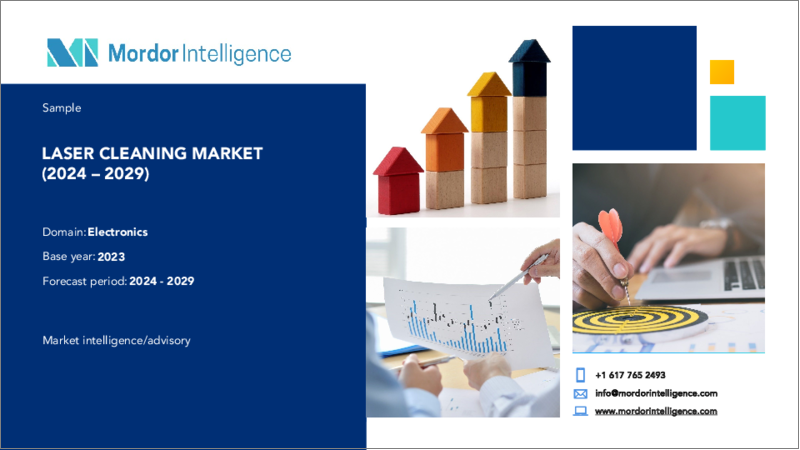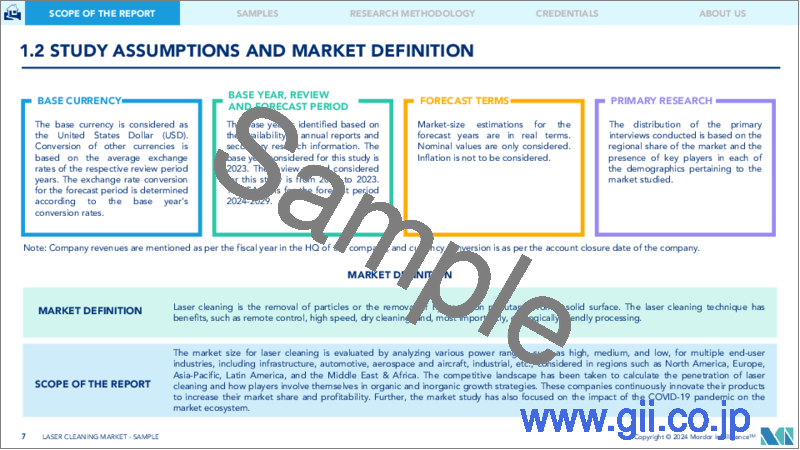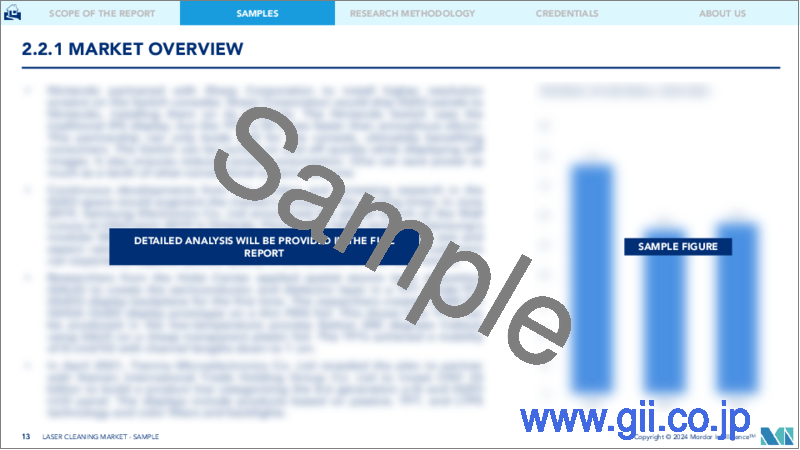|
|
市場調査レポート
商品コード
1405089
レーザークリーニング:市場シェア分析、産業動向と統計、2024~2029年の成長予測Laser Cleaning - Market Share Analysis, Industry Trends & Statistics, Growth Forecasts 2024 - 2029 |
||||||
|
● お客様のご希望に応じて、既存データの加工や未掲載情報(例:国別セグメント)の追加などの対応が可能です。 詳細はお問い合わせください。 |
|||||||
| レーザークリーニング:市場シェア分析、産業動向と統計、2024~2029年の成長予測 |
|
出版日: 2024年01月04日
発行: Mordor Intelligence
ページ情報: 英文 143 Pages
納期: 2~3営業日
|
- 全表示
- 概要
- 目次
レーザークリーニング市場規模は、2024年の7億8,000万米ドルから2029年には15億米ドルに成長すると予測、予測期間中のCAGRは14.61%。
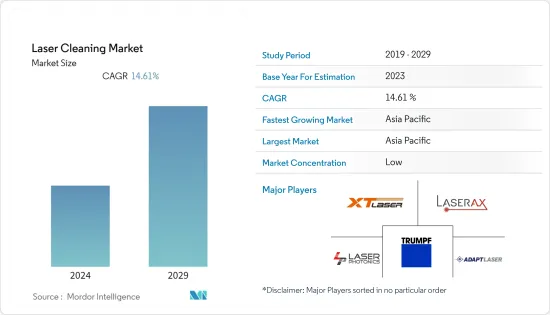
主要ハイライト
- レーザークリーニングは、様々な産業で重要なフェーズ/プロセスとなっています。主に製造業で採用されているレーザークリーニングは、洗練された生産が増加するにつれて、ハードウェア技術が何度もアップグレードされています。
- 従来は、後続の工業プロセスのための表面処理に使用されていたが、インダストリー4.0がもたらす変化に対応するため、自動化された洗浄プロセスが求められています。また、研磨ブラストシステムは廃棄物を大量に発生させ、デリケートな表面を傷つけ、化学溶剤の使用は潜在的に危険な蒸気や廃液を発生させる。このような問題から、表面クリーニングにレーザー技術をベースとしたソリューションが採用されるようになった。
- このような従来のアプローチに比べ、レーザー洗浄の潜在的な利点が高いことから、レーザー洗浄の採用が進んでいます。さらに、レーザークリーニングは半導体の正確で精密なクリーニングを可能にし、エレクトロニクス産業での採用を後押ししています。
- 信頼性に対する要求の高まりと、無洗浄手順によって生じる電子部品のエラーの増加により、エレクトロニクス製造業界は洗浄に再注目せざるを得なくなった。クリーニング業界は、理想的なクリーニング方法を決定するための幅広い選択肢を提供し、レーザークリーニング市場の成長を促進しています。
- レーザークリーニング装置の高価格と技術的専門知識の不足が市場成長の課題となっています。レーザークリーニング装置の95%の価格は、1台当たり75万インドルピー(9153.43米ドル)から550万インドルピー(67125.13米ドル)です。
- COVID-19の期間中、細菌に感染した表面のレーザークリーニングは、レーザーの熱効果が表面の殺菌に使用されるため、非常に効果的な手順として浮上しました。レーザーは通常パルス状であるが、波長、パルスエネルギー、繰り返し周波数は慎重に選択されなければならないです。このような動向は、調査された市場の成長にプラスに寄与すると予想されます。
レーザークリーニング市場動向
自動車分野が大きな成長を遂げる
- レーザークリーニングは、目に見えるものだけでなく、すべての汚染物質を除去します。自動車でレーザークリーニングを使用する主要例としては、腐食除去、コーティング除去、トップコート選択除去、自動車生産またはメンテナンスにおける酸化物処理などがあります。
- レーザークリーニングは、すべてのオリジナル部品があり、表面の状態が良い高価値の車を復元することができます。軽微な腐食のある素晴らしい車は、特に年数が経つにつれて入手が難しくなります。Adapt Laser Systemsによると、GM、Toyota、Michelinなどの自動車メーカーは、クリーニングを含むレーザー技術で同団体と提携しています。
- これに加え、電気自動車需要の大幅な伸びとレーザー洗浄機の実際の導入が、予測期間中の需要をさらに押し上げると分析しています。レーザークリーニングでは、不純物を吸収して除去するために毎秒数1,000パルスが使用されます。これは主に、接合練習や溶接前工程が必要な自動車部品にメリットがあります。企業は、接合や処理の前に汚染物質を除去することで、バッテリーや電気自動車の部品をつなぎ合わせる化学的特性を改善し、製品の寿命を延ばすことができます。コーティング除去、射出成形金型処理、溶接後処理、タイヤ金型洗浄はすべて、レーザー洗浄の可能な用途です。
- レーザーシステムによるバッテリー部品のクリーニングは、アブレーションプロセスを1~3ミクロンレベルの材料除去まで管理しながら、生産者が迅速かつ安全に作業することを可能にします。これにより、基材層が無傷のまま維持されやすくなり、その結果、非洗浄部分よりもはるかに優れた接続が実現し、時間やマイルに対する接合安定性が大幅に改善されます。レーザーアブレーションは、バッテリーセルとボンディングワイヤー間の導電性を向上させるため、電気自動車(EV)バッテリーの洗浄方法を大きく変えます。ほとんどのメーカーは、従来の光伝送でEVバッテリーをクリーニングするために、一般的なパルスファイバーレーザーを採用しています。これは素晴らしい多目的技術ですが、EV産業だけに対応しているわけではありません。
- 例えば、EVの生産台数の増加は、調査された市場を推進すると予想されます。例えば、Teslaは2022年2月、中国国内と輸出市場での需要増に対応するため、中国に2つ目の電気自動車(EV)施設の建設を計画しました。短期的には、Teslaは中国での生産能力を少なくとも年間100万台まで引き上げる計画で、上海の臨港自由貿易区にある現在の生産拠点の近くに第2工場を設計します。
- IEAによると、2022年には世界中でおよそ2,590万台の電気自動車が稼働しています。同年のプラグイン電気自動車に占める全電気自動車の割合は約69.5%でした。
- さらに2022年5月、Toyota Groupはインドに480億インドルピー(6億2,400万米ドル)を投資し、電気自動車部品を製造する計画を明らかにしました。さらに、インドにおける電気モビリティへの最初の関心と露出は、ハイブリッド車とEVsFAME IとIIの迅速な導入と生産を目的としたNational Electric Mobility Mission Planによってもたらされました。政府は、FAMEの第2段階として、現在から2022年までの間に総額14億米ドルを支出すると発表しています。このような自動車の拡大により、研究市場の成長はさらに刺激される可能性があります。
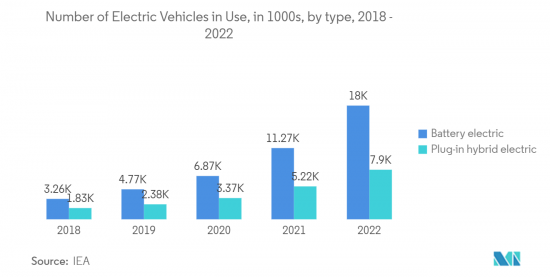
アジア太平洋が急成長市場になる見込み
- 中国は環境保護の分野でより厳しくなっており、市民は汚染から身を守ることにますます関心を持つようになっています。特に、レーザー洗浄ソリューションの需要の主要理由となっている公害問題は、伝統的な洗浄産業で観察することができます。
- さらに、中国の製造工程は、レーザーを重要な支援技術として、より高いレベルまで上昇しており、国の国家戦略である「インダストリー4.0」と「メイド・イン・チャイナ2025」によって、準備が整い、成熟しています。
- 同市場では、材料加工用レーザーの性能向上が見込まれており、日本の産業領域では有望なレーザー処理用途の数が増加しています。また、レーザーを正しく利用するために、レーザーサイエンスに基づくレーザー加工技術の高度化・体系化、高品質な製造のための生産技術、レーザー調査・技術者の増加が進んでいます。
- さらに、インドの都市部では70%以上の人々がより多くのホームクリーニング製品を購入しているため、市場はより健康的な家庭を作るためのイノベーションを見ています。例えば、2022年2月、Dysonはインド初のレーザー検出技術を搭載した掃除機を発表しました。この掃除機は、わずか10ミリの微細なゴミまで検知できるよう設計されています。Dyson V12 Detect Slimは、最大150ワットの強力な吸引力を生み出すハイパーダイミウム・モーターを搭載した新しいコードレス掃除機です。5段階のフィルターシステムにより、0.3ミクロンのホコリを99.9%捕集します。
- 溶接前と溶接後の最高レベルの処理を保証するレーザー洗浄機の必要性は、韓国での大きな自動車需要により、コーティング工程を経ることなく十分なコーティングが可能な、成長した強固な接続をもたらします。レーザー洗浄機の需要は、有害な化学物質や廃棄物の使用や、酸化剤による汚染の除去、射出成形金型の消毒、耐腐食性、ボンドの準備などの他の用途のために増加しています。KAIDAによると、2022年には韓国で約85万1,000台のガソリン車が販売されました。次に人気のある燃料タイプはディーゼルで、ハイブリッド車が3位に続いた。同年の電気自動車やハイブリッド車の販売台数は、前年に比べて大幅に増加しました。
- 2022年2月、韓国の電池メーカーであるSamsung SDIは、レーザー装置による角型電池缶の洗浄を開始しました。角形電池では、正極、負極、セパレーターなどの材料が金属容器に蒸着されています。缶に挿入される前に、これらの部品はゼリー状に成形されます。レーザーは、ゼリーロールが挿入された直後、缶の開口部がキャップで密閉される前に開始されます。
- その他のアジア太平洋には、オーストラリア、タイ、インドネシアなど、予測期間中に調査市場で大きな成長が見込まれるアジア諸国が含まれます。
レーザークリーニング業界概要
レーザークリーニング市場は、多くの地域と国際的な参入企業によって断片化されています。市場が細分化されているため、参入企業間の競合は激しく、様々な新規参入企業がこの市場に投資しています。Jinan Xintian Technology(XT Laser)、TRUMPF Group、Laser Photonics Corporation、Laserax Inc.、Adapt Laser Systemsがこの市場における重要な参入企業です。同市場の参入企業は、製品ラインナップを強化し、持続可能な競争優位性を獲得するために、パートナーシップ、イノベーション、買収などの戦略を採用しています。
- 2022年5月-Laser Photonics Corp.は、CleanTech3000-CTHレーザークリーニングシステムを発表しました。CleanTech3000-CTHレーザークリーニングシステムは、最も困難な腐食を除去し、塗装前の接着を改善できるハンドヘルドレーザークリーニング装置。このシステムには統合型チラーが含まれており、以前は商業業界で最も効率的であった2000-CTHと同じサイズです。Laser Photonics CleanTechハンドヘルドシリーズの"Roughing"レーザーは、Laser Photonicsクリーニングレーザーセレクションガイドに記載されているように、3KWレーザーブラスタの導入により拡大されました。
- 2022年4月-レーザークリーニング用ハイテクレーザーシステムを提供するLaser Photonics Corp.は、既存製品ラインのアップグレードを発表しました。クラスIVからクラスIのレーザーブラスターキャビネット、自動レーザークリーニング装置、ロボットアプリケーションなど、すべての製品ラインに進歩が見られます。また、2022年5月、Laser Photonics Corp.はCleanTech3000-CTHレーザークリーニングシステム(3KW)の発売を発表しました。
- 2022年3月-IPG Photonicsは、レーザークリーニングのポートフォリオを絶えずアップグレードしており、ハンドヘルドレーザー溶接・クリーニング製品ラインの第3の製品であるLightWELDXRを発売しました。この新製品は、ハンドヘルド・レーザー溶接とクリーニング機能を拡大し、従来のLightWELDモデルよりも多くの材料と板厚に対応します。これは、はるかに小さいスポットサイズを生成し、6倍以上のエネルギー密度を提供することによって実現されます。
その他の特典:
- エクセル形式の市場予測(ME)シート
- 3ヶ月のアナリスト・サポート
目次
第1章 イントロダクション
- 調査の前提条件と市場定義
- 調査範囲
第2章 調査手法
第3章 エグゼクティブサマリー
第4章 市場洞察
- 市場概要
- 業界の魅力度-ポーターのファイブフォース分析
- 供給企業の交渉力
- 買い手の交渉力
- 新規参入業者の脅威
- 代替品の脅威
- 競争企業間の敵対関係
- 産業バリューチェーン分析
- マクロ経済動向の市場への影響
第5章 市場力学
- 市場促進要因
- 従来の手法に対するレーザークリーニングの採用
- 電子部品における小型化の採用増加
- 市場抑制要因
- 高コストと専門技術者の不足
第6章 市場セグメンテーション
- 出力範囲別
- 高
- 中
- 低
- エンドユーザー産業別
- インフラ
- 自動車
- 航空宇宙・航空機
- 産業用
- その他のエンドユーザー産業
- 地域別
- 北米
- 米国
- カナダ
- 欧州
- 英国
- ドイツ
- フランス
- イタリア
- その他の欧州
- アジア太平洋
- 中国
- インド
- 日本
- 韓国
- その他のアジア太平洋
- ラテンアメリカ
- 中東・アフリカ
- 北米
第7章 競合情勢
- 企業プロファイル
- Jinan Xintian Technology Co., Ltd(XT Laser)
- TRUMPF Group
- Laser Photonics Corporation
- Laserax Inc.
- Adapt Laser Systems
- Clean-Lasersysteme GmbH
- P-Laser
- IPG Photonics Corporation
- Scantech Laser Pvt. Ltd
- Anilox Roll Cleaning Systems
- HGLaser Engineering Co. Ltd
- Coherent Corp.
第8章 投資分析
第9章 市場の将来

The Laser Cleaning Market size is expected to grow from USD 0.78 billion in 2024 to USD 1.5 billion by 2029, at a CAGR of 14.61% during the forecast period.
Key Highlights
- Laser cleaning has become a vital phase/process in various industries. Adopted mainly in manufacturing, laser cleaning has witnessed multiple upgrades to the hardware technology as sophisticated production is on the rise.
- Conventionally being used to prepare surfaces for subsequent industrial processes, automated cleaning processes are required to adhere to changes brought in by Industry 4.0. Also, abrasive blasting systems create substantial waste and damage delicate surfaces, and the use of chemical solvents causes potentially hazardous vapors and liquid waste products. Such issues led to the adoption of laser technology-based solutions for surface cleaning.
- The potentially high benefits of laser cleaning over these conventional approaches have been driving the adoption of laser cleaning. Further, laser cleaning provides accurate and precise cleaning of semiconductors, driving their adoption in the electronics industry.
- The increased demand for reliability and the increasing number of errors in electronic components created by no-clean procedures compelled the electronics manufacturing industry to refocus on cleaning. The cleaning industry provides a wide range of options for determining the ideal cleaning method, driving the growth of the laser cleaning market.
- The high price of laser cleaning equipment and lack of technical expertise poses a challenge to the market's growth. The price of 95% of laser cleaning machines is between INR 750,000 (USD 9153.43) and INR 5,500,000 (USD 67125.13) per piece.
- During the COVID-19 period, laser cleaning of bacteria-infected surfaces emerged as a highly effective procedure as the thermal effects of the laser was used to disinfect the surface.Various studies have been conducted to determine the efficacy of multiple types of lasers in cleaning bacteria-infested surfaces. The lasers are usually pulsed, but the wavelength, pulse energy, and repetition rate must be carefully selected. Such trends are expected to contribute positively to the studied market's growth.
Laser Cleaning Market Trends
Automotive Sector to Witness Major Growth
- Laser cleaning removes all contaminants, not just those that are visible. The significant instances where I used laser cleaning in automotive include corrosion removal, coating removal, topcoat select removal, oxide treatment in automotive production or maintenance, etc.
- Laser cleaning can restore a high-value vehicle that has all its original parts and is in good condition on the surface. Great cars with minor corrosion are tough to obtain, especially as they age. According to Adapt Laser Systems, automotive manufacturers such as GM, Toyota, Michelin, and others have partnered with the organization for laser technologies, including cleaning.
- Adding to this, the significant growth in the demand for electric vehicles and the actual deployment of laser cleaning machines is further analyzed to boost the demand during the forecast period. Thousands of pulses per second are used in laser cleaning to absorb and eliminate impurities. This mainly benefits automotive parts that require bonding practice and pre-weld processes. Companies can improve the chemical characteristics that hold the battery or electric car parts together and extend the product's lifespan by eliminating pollutants before bonding or treating them. Coating removal, injection mold treatment, post-weld treatment, and tire mold cleaning are all possible applications for laser cleaning.
- Cleaning battery components with a laser system enables producers to work fast and safely while managing the ablation process down to 1 to 3-micron levels of material removal. This keeps the substrate layer intact easier, resulting in connections far superior to non-cleaned areas and significantly improved bond stability over time and miles. Laser ablation is a game-changing electric vehicle (EV) battery cleaning method because it improves conductivity between the battery cell and the bonding wire. Most manufacturers employ a typical pulsed fiber laser to clean EV batteries with conventional optical delivery. This is a terrific multi-purpose technique but does not exclusively cater to the EV industry.
- For instance, the rise in the production of EVs is expected to propel the Market studied. For example, in February 2022, Tesla planned to build a second electric vehicle (EV) facility in China to help it keep up with increasing demand locally and in export markets. In the short term, Tesla plans to increase capability in China to at least 1 million cars per year, with a second plant designed near its current production in Shanghai's Lingangfree trade zone.
- According to IEA, roughly 25.9 million electric vehicles were operating worldwide in 2022. All-electric cars accounted for about 69.5% of plug-in electric vehicles that year.
- Further, in May 2022, Toyota Group revealed plans to invest INR 48 billion (USD 624 million) in India to manufacture electric vehicle components. In addition, The first interest and exposure for electric mobility in India was driven by the National Electric Mobility Mission Plan, which is aimed at faster adoption and production of hybrids and EVsFAME I and II. The government has announced an expenditure totalling USD 1.4 billion between now and 2022, in the second phase of FAME. The study market growth can be further stimulated by such an expansion of motor vehicles.

Asia Pacific is Expected to be the Fastest Growing Market
- China has become more stringent in the field of environment protection and citizens are increasingly concerned with protecting themselves from pollution. A growing number of issues, in particular pollution problems that are a major reason for the demand for laser cleaning solutions, can be observed in the Traditional Cleaning Industry.
- Moreover, China's manufacturing processing is rising to a higher level, with lasers as the significant supporting technology and significantly becoming ready and mature due to the country's national strategies "Industry 4.0" and "Made in China 2025., which are expected to bring increased opportunities for various vendors offering laser cleaning systems.
- The market is expected to witness an increased performance of lasers for materials processing, and the number of promising laser treatment applications is growing in Japan's industrial domains. Furthermore, to correctly employ lasers, laser processing technology is being created based on laser science for enhancement and systematization, production technology for manufacturing high-quality items, and an increase in the number of laser researchers and engineers.
- Further, the market sees innovations to help create healthier homes as over 70% of people in urban India buy more home-cleaning products. For instance, in February 2022, Dyson announced India's first vacuum cleaner with laser detection technology. The vacuum cleaner is designed to detect concealed particles as small as 10 millimeters. The Dyson V12 Detect Slim is a new cordless vacuum cleaner with a hyperdymium motor that generates up to 150 air watts of intense suction. Its five-stage filtration system collects 99.9% of dust particles as small as 0.3 microns.
- The necessity for laser cleaning machines to ensure the highest possible prewelding and postwelding treatment results in a growing and strong connection, which can be sufficiently coated without being subjected to any coating process, due to significant automotive demand in South Korea Increased demand for laser cleaning machines has been observed due to the use of harmful chemicals or wastes and other uses such as removal of contamination by oxidising agents, injection mold disinfection, corrosion resistance and Bond preparation. According to KAIDA, in 2022, around 851 thousand gasoline vehicles were sold in South Korea. The next popular fuel type was diesel, followed by hybrid cars in third place. That year, the sales of electric or hybrid vehicles noticed a large increase compared to the last year.
- In February 2022, Samsung SDI, a South Korean battery manufacturer, started cleaning prismatic battery cans with laser equipment. Materials, including cathode, anode, and separators, are deposited in a metal container in prismatic batteries. Before being inserted into the can, these components are formed into a jelly roll. The laser begins immediately after the jelly roll is inserted and before the can's opening is sealed with a cap.
- Other Asian countries, such as Australia, Thailand, and Indonesia, which are expected to grow significantly in the studied market during the forecast period, are included in the rest of the Asia Pacific segment.
Laser Cleaning Industry Overview
The laser cleaning market is fragmented due to many regional and international players. Due to the fragmented nature of the Market, the competition amongst the players is high, and various new players are also investing in this Market. Jinan Xintian Technology Co., Ltd (XT Laser), TRUMPF Group, Laser Photonics Corporation, Laserax Inc., and Adapt Laser Systems are critical players in the Market. Players in the Market are adopting strategies such as partnerships, innovations, and acquisitions to enhance their product offerings and gain sustainable competitive advantage.
- May 2022 - Laser Photonics Corp. launched the CleanTech3000-CTH laser cleaning system. The CleanTech3000-CTH laser cleaning system is a handheld laser cleaning equipment capable of removing the most challenging corrosion and improving adhesion before painting. This system includes an integrated chiller and is the same size as the 2000-CTH, which was formerly the most efficient for the commercial industry. The Laser Photonics CleanTech Handheld series of "Roughing" lasers was expanded by introducing the 3KW laser blaster, as stated in the Laser Photonics Cleaning Laser selection guide.
- April 2022 - Laser Photonics Corp., a provider of high-tech laser systems for laser cleaning, announced the upgrades to the existing product line. Advancements are being made to the entire product line, which includes everything from Class IV to Class I laser blaster cabinets, automatic laser cleaning equipment, and robotic applications. Also, in May 2022, Laser Photonics Corp. announced the launch of the CleanTech3000-CTH laser cleaning system (3KW).
- March 2022 - IPG Photonics constantly upgraded its laser cleaning portfolio; the company launched LightWELDXR, the third product offering within its handheld laser welding and cleaning product line. The new product provides an extended range of handheld laser welding and cleaning capabilities to address more materials and thicknesses than previous LightWELDmodels. This is done by producing a much smaller spot size and delivering more than six times the energy density.
Additional Benefits:
- The market estimate (ME) sheet in Excel format
- 3 months of analyst support
TABLE OF CONTENTS
1 INTRODUCTION
- 1.1 Study Assumptions and Market Definition
- 1.2 Scope of the Study
2 RESEARCH METHODOLOGY
3 EXECUTIVE SUMMARY
4 MARKET INSIGHTS
- 4.1 Market Overview
- 4.2 Industry Attractiveness - Porter's Five Forces Analysis
- 4.2.1 Bargaining Power of Suppliers
- 4.2.2 Bargaining Power of Buyers
- 4.2.3 Threat of New Entrants
- 4.2.4 Threat of Substitutes
- 4.2.5 Intensity of Competitive Rivalry
- 4.3 Industry Value Chain Analysis
- 4.4 Impact of Macroeconomic Trends on the Market
5 MARKET DYNAMICS
- 5.1 Market Drivers
- 5.1.1 Adoption of Laser Cleaning over Traditional Approach
- 5.1.2 Increasing Adoption of Miniaturization in Electronic Components
- 5.2 Market Restraints
- 5.2.1 High Cost and Lack of Technical Expertise
6 MARKET SEGMENTATION
- 6.1 By Power Range
- 6.1.1 High
- 6.1.2 Medium
- 6.1.3 Low
- 6.2 By End-user Industry
- 6.2.1 Infrastructure
- 6.2.2 Automotive
- 6.2.3 Aerospace and Aircraft
- 6.2.4 Industrial
- 6.2.5 Other End Users
- 6.3 By Geography
- 6.3.1 North America
- 6.3.1.1 United States
- 6.3.1.2 Canada
- 6.3.2 Europe
- 6.3.2.1 United Kingdom
- 6.3.2.2 Germany
- 6.3.2.3 France
- 6.3.2.4 Italy
- 6.3.2.5 Rest of Europe
- 6.3.3 Asia Pacific
- 6.3.3.1 China
- 6.3.3.2 India
- 6.3.3.3 Japan
- 6.3.3.4 South Korea
- 6.3.3.5 Rest of the Asia Pacific
- 6.3.4 Latin America
- 6.3.5 Middle East and Africa
- 6.3.1 North America
7 COMPETITIVE LANDSCAPE
- 7.1 Company Profiles
- 7.1.1 Jinan Xintian Technology Co., Ltd (XT Laser)
- 7.1.2 TRUMPF Group
- 7.1.3 Laser Photonics Corporation
- 7.1.4 Laserax Inc.
- 7.1.5 Adapt Laser Systems
- 7.1.6 Clean -Lasersysteme GmbH
- 7.1.7 P-Laser
- 7.1.8 IPG Photonics Corporation
- 7.1.9 Scantech Laser Pvt. Ltd
- 7.1.10 Anilox Roll Cleaning Systems
- 7.1.11 HGLaser Engineering Co. Ltd
- 7.1.12 Coherent Corp.
